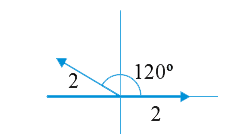According to triangle law of vector addition, the direction of the resultant is given by :
tanα=PcosθP+Qsinθ
tanα=QsinθP+Qcosθ
tanα=QcosθP+Qsinθ
tanα=QcosθQsinθ
The correct Answer is:B
Topper's Solved these Questions
- KINEMATICS BOOK - PREMIERS PUBLISHERSCHAPTER - KINEMATICS EXERCISE - Other important questions & answers (II. Very short answer questions).
112 Videos
- KINEMATICS BOOK - PREMIERS PUBLISHERSCHAPTER - KINEMATICS EXERCISE - Other important questions & answers (III. Short answer questions).
26 Videos
- KINEMATICS BOOK - PREMIERS PUBLISHERSCHAPTER - KINEMATICS EXERCISE - Textbook questions & answers (IV. Numerical problems).
48 Videos
- GRAVITATIONBOOK - PREMIERS PUBLISHERSCHAPTER - GRAVITATIONEXERCISE - OTHER IMPORTANT QUESTION & ANSWERS (CONCEPTUAL QUESTIONS)
34 Videos
- KINETIC THEORY OF GASESBOOK - PREMIERS PUBLISHERSCHAPTER - KINETIC THEORY OF GASESEXERCISE - OTHER IMPORTANT QUESTIONS & ANSWERS (VI. Conceptual Questions.)
8 Videos
Similar Questions
Knowledge Check
In parallelogram law of vector, the direction of resultant vector is given by
Atanα=QcosθP+QsinθBtanα=QsinθP+QcosθCtanα=PsinθP+QcosθDtanα=PcosθP+Qcosθ
Find the magnitude and direction of the resultant of given vectors

View SolutionState parallelogram of law of vector addition .
View SolutionTriangle Law Of Addition Of Vectors
View SolutionAccording to parallelogram law of vectors the magnitude of resultant of two vectors ¯¯¯A and ¯¯¯B is
View Solution(a) Write law of parallelogram of vector and obtain the expression for the resultant of two vectors acting in two different directions.
View SolutionExplain the law of addition of vectors.
View SolutionState parallelogram law of vector addition. Find analytically the magnitude and direction of resultant vector. Apply it to find the resultant when,
(i) Two vectors are parallel to each other
(ii) Two vectors are perpendicular to each other
View Solution
